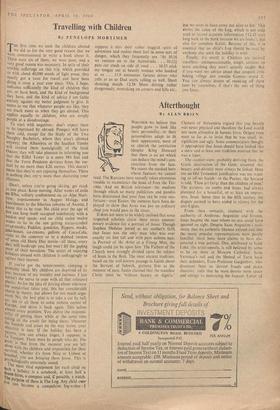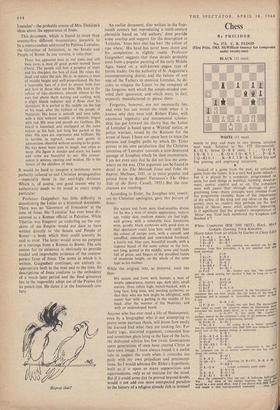Afterthought
By ALAN BRIE N
It does not seem to be widely realised that some respected scholars claim' there' exists contem- porary evidence for a portrait of Jesus. Though Stephen Dedalus jeered at his mother's faith that Jesus was the only man who was ever exactly six feet tall and with pure auburn hair, in Portrait of the Artist as a Young Man, the laugh could yet be upon him. The Fathers of the Church were strongly divided upon the subject of Jesus in the flesh. The most ancient tradition, based on the well-known passage in Isaiah about the Servant of Jahweh, pictures him as the meanest of men. Justin claimed that the manifest Christ must be 'without beauty or dignity.'
Clement of Alexandria argued that true beauty was never physical and therefore the Lord would not seem attractive in human form. Origen even went so far as to insist that he was small, in- significant and ugly. Some commentators thought it appropriate that Jesus should have looked like a slave and at least one tradition asserted that he was a leper.
The counter-view, probably deriving from the Greek idealisation of the Gods, assumed that beauty and divinity must always be linked. Here too an Old Testament justification was not want- ing to off-set Isaiah—in the Psalms, the Saviour is told, 'Thou art fairer than the children of men' The painters, on tombs and ikons, had al%+ays plumped for a beautiful, or at least an impres- sive, Jesus. Some time in the fifth century the dispute seemed to have ended in victory for the anti-Uglies.
From then onwards, stamped with the authority of Ambrose, Augustine and Jerome, Jesus became the man whom no one could have ignored on sight. Despite Saint Augustine's testi- mony that no authentic likeness existed and that the many popular representations were purely fanciful, there have been claims to have dis- covered a true portrait. One, attributed to Saint Luke, the artist-apostle, is still believed by some to be on show in Moscow Cathedral. Saint Veronica's veil and the Shroud of Turin have their defenders. Even Professor Guignebert. who dismisses these as 'devout frauds and pious illusions.' feels that he must devote more space and energy to destroying the famous 'Letter of
Lentulus'—the probable source of Mrs. Dedalus's ideas about the appearance of Jesus.
This document, which is found in more than seventy-five different manuscripts, ,Purports to be a memorandum addressed by Publius Lentulus, the Governor of Jerusalem, to the Senate and People of Rome. In one version, it runs thus: There has appeared here in our time, and still lives here, a man of great power named Jesus Christ. The people call him a prophet of truth and his disciples, the Son of God. He raises the dead and cures the Sick. He is, in stature, a man of middle height and well-proportioned. He has a venerable face of a sort to arouse both fear and love in those who see him. His hair is the colour of ripe chestnuts, smooth almost to the ears but above them waving and curling, with a slight bluish radiance and it flows over his shoulders.' It is parted in the middle on the top of his head, after the fashion of the people of Nazareth. His brow is smooth and very calm, with a face without wrinkle or blemish, tinged with red. His nose and mouth are faultless. His beard is luxuriant and unclipped of the same colour as his hair, not long but parted at the chin. His eyes are expressive and brilliant. He is terrible in reproof, sweet and gentle in admonition, cheerful without ceasing to be grave. He has never been seen to laugh, but often. to weep. His figure is slender and erect; his hands and arms are beautiful to see. His conver- sation is serious, sparing and modest. He is the fairest of the children of men.
It would be hard to imagine a testimony more perfectly tailored to suit Christian propagandists —especially those in the anti-Ugly division. Which is, of course, one good reason why its authenticity needs to be tested in every single particular.
Professor Guignebert has little difficulty in demolishing the Letter as a historical document. There was no 'Governor of Jerusalem' at the time of Jesus. No `Lentulus' has ever been dis- covered as a Roman official in Palestine. While Tiberius was Emperor an underling on the out- skirts of the Empire would not dare to have written directly to 'the Senate and People of Rome'—a body which then could scarcely be said to exist. The letter would serve no purpose as a message from a, Roman to Rome. The sole reason for its existence is obviously to provide loaded and improbable evidence of the contem- porary fame of Jesus. The terms in which it is written, Guignebert continues, are entirely in- appropriate both to the man and to the time. Its descriptions of Jesus conform to the orthodoxy of a much later period and the final giveaway lies in the impossibly adept use of the Psalms for its punch-line. He dates it in the fourteenth cen- tury.
'Repeat that!' An earlier document, also written in the four- teenth century but reproducing a tenth-century chronicle based on 'old authors,' does provide some overlap and support for the description in `Lentulus.' Jesus here also has hair 'the colour of ripe wheat.' His head has never been shorn and his complexion is slightly ruddy. Professor Guignebert suggests that these details probably stem from a popular painting of the early Middle Ages, based on a well-known pagan type of heroic leader. On the authority of St. Augustine's uncompromising denial, and the failure of any one of the Fathers to mention Lentulus, he de- cides to. relegate the Letter 'to the company of the forgeries with which the simple-minded con- soled their ignorance, and which were, in fact, expressly manufactured to please them:
Forgeries, however, are not necessarily lies, and even lies can reveal the truth when it is known why they were told. Robert Eisler, with enormous ingenuity and monumental scholar- ship, has put forward the theory that the 'Letter of Lentulus' is based upon a 'Wanted' notice, or police warrant, issued by the Romans for the arrest of Jesus. I have not space here to trace the devious and lengthy paths by which Dr. Eisler proves to his own satisfaction that the Christian invention of `Lentulus' conceals a now-destroyed passage of Josephus which he then reconstructs.
am not even sure that he did not lose me some- where on the way. (The argument can be found in detail in his The Messiah Jesus and John the Baptist, Methuen, 1931, or in more popular and potted form in Rupert Furneaux's The Other Side of the Story, Cassell, 1953.) But the con- clusions are startling.
According to Eisler, the Josephus text, rewrit- ten by Christian apologists, gave this picture of Jesus:
His nature and form were God-manlike divine for he Was a man of simple appearance, mature age, ruddy skin, medium stature, six feet high, well grown, with a venerable face, handsome nose, goodly black eyebrows with good eyes so that spectators could love him, with curly hair the colour of unripe corn, with a smooth and unruffled, unmarked and unwrinkled forehead, a lovely red, blue eyes, beautiful mouth, with a copious beard of the same colour as the hair, not long, parted in the middle, arms and hands full of grace, and fingers of the unsullied hands of moderate length, on the whole of the.same type' as his mother.
While the original text, as restored, once ran thus: His nature and form were human; a man of simple appearance, mature age, dark skin, small stature, three cubits high, hunch-backed, with a long face, long nose, and meeting eyebrows, so that they who see him might be affrighted, with scanty hair with a parting in the middle of his head, after the manner of the Nazirites, and with an undeveloped beard.
Anyone who has ever read a life of Shakespeare, even by a biographer who is not attempting to prove some partisan thesis, will know how easily the learned find what they are looking for. For faulty logic, distorted argument, concealed bias and sometimes plain lying in the face of the facts, the dedicated scholar has few rivals. Generations upon generations of men have created Christ in their own image. I have always found it a useful rule to suspect the truth when it coincides too patly with my own prejudices and preconcep- tions. So I would advance Dr. Eisler's hypothesis, built as it is upon so many suppositions and equivocations, only as an exercise for the mind. But if it could some day be proved beyond doubt, would it not add one more unexpected paradox to the history of a religion already rich in ironies?







































 Previous page
Previous page